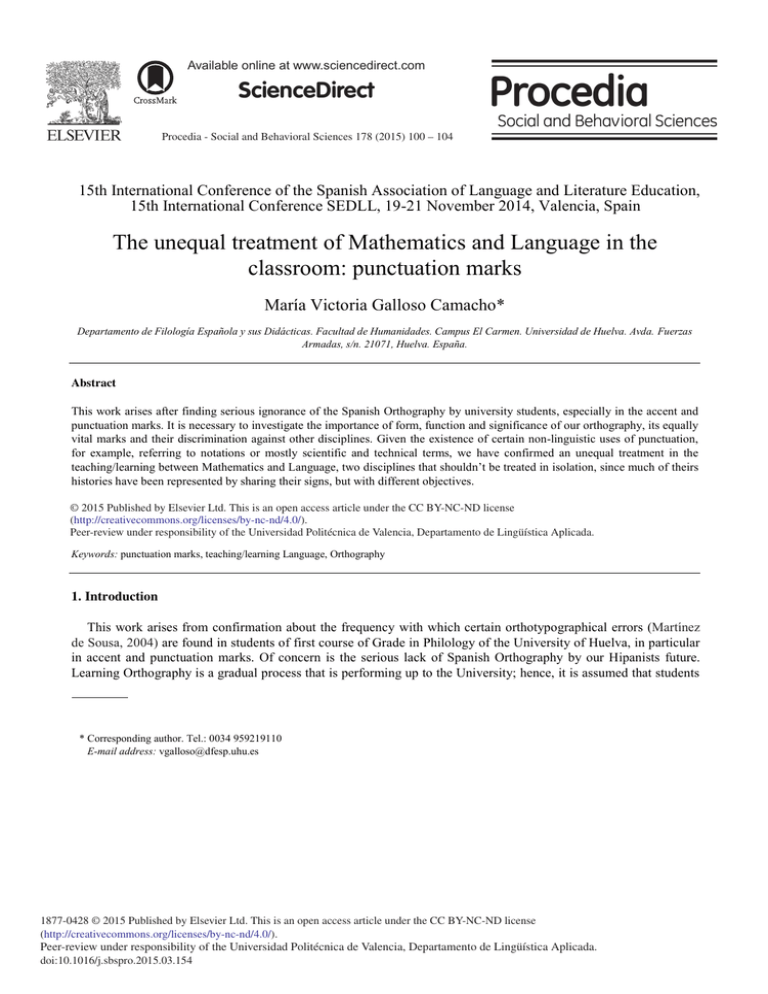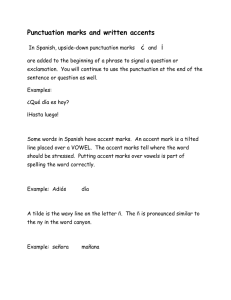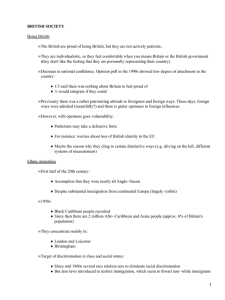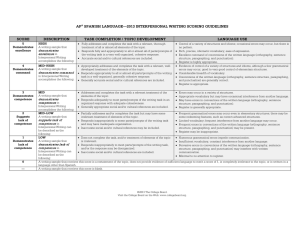The Unequal Treatment of Mathematics and Language in the
Anuncio

Available online at www.sciencedirect.com ScienceDirect Procedia - Social and Behavioral Sciences 178 (2015) 100 – 104 15th International Conference of the Spanish Association of Language and Literature Education, 15th International Conference SEDLL, 19-21 November 2014, Valencia, Spain The unequal treatment of Mathematics and Language in the classroom: punctuation marks María Victoria Galloso Camacho* Departamento de Filología Española y sus Didácticas. Facultad de Humanidades. Campus El Carmen. Universidad de Huelva. Avda. Fuerzas Armadas, s/n. 21071, Huelva. España. Abstract This work arises after finding serious ignorance of the Spanish Orthography by university students, especially in the accent and punctuation marks. It is necessary to investigate the importance of form, function and significance of our orthography, its equally vital marks and their discrimination against other disciplines. Given the existence of certain non-linguistic uses of punctuation, for example, referring to notations or mostly scientific and technical terms, we have confirmed an unequal treatment in the teaching/learning between Mathematics and Language, two disciplines that shouldn’t be treated in isolation, since much of theirs histories have been represented by sharing their signs, but with different objectives. © by Elsevier Ltd. by This is an open © 2015 2015Published The Authors. Published Elsevier Ltd.access article under the CC BY-NC-ND license (http://creativecommons.org/licenses/by-nc-nd/4.0/). Peer-reviewunder underresponsibility responsibility of the Universidad Politécnica de Valencia, Departamento de Lingüística Aplicada. Peer-review of the Universidad Politécnica de Valencia, Departamento de Lingüística Aplicada. Keywords: punctuation marks, teaching/learning Language, Orthography 1. Introduction This work arises from confirmation about the frequency with which certain orthotypographical errors (Martínez de Sousa, 2004) are found in students of first course of Grade in Philology of the University of Huelva, in particular in accent and punctuation marks. Of concern is the serious lack of Spanish Orthography by our Hipanists future. Learning Orthography is a gradual process that is performing up to the University; hence, it is assumed that students * Corresponding author. Tel.: 0034 959219110 E-mail address: [email protected] 1877-0428 © 2015 Published by Elsevier Ltd. This is an open access article under the CC BY-NC-ND license (http://creativecommons.org/licenses/by-nc-nd/4.0/). Peer-review under responsibility of the Universidad Politécnica de Valencia, Departamento de Lingüística Aplicada. doi:10.1016/j.sbspro.2015.03.154 María Victoria Galloso Camacho / Procedia - Social and Behavioral Sciences 178 (2015) 100 – 104 should get to this level with a solid and certain knowledge. However, the observation and analysis of the work performed during the academic year reveal not acceptable basic shortcomings and lacks carried, safely, from the Primary level. Why is a serious error that, in a mathematical sum, its structure and basic signs or the result of it is missing, while in Language the absence of accent or punctuation marks on a written test is not treated with the same rigour and demand? 2. Analysis Communication is much richer when it is better written. Language professors are responsible for that, in any academic field, a trifle than a sentence or text you a missing comma or an accent on letter is considered. Are trifles the lacks of basic signs in the area of Mathematics since Primary? It is necessary to investigate the importance of form, function and significance of our Orthography, its equally vital signs and its discrimination against other disciplines. Punctuation and accent marks on writing help, with its emphasis, to convey the message clearly and accurately, so that in speech, is achieved with the right intonation. In writing, however, the receiver of the message doesn’t get the gestures and intonations of the transmitter or the message itself. The labor of punctuation, then, is so important that the message can be distorted if punctuation and accent marks are not located in the right place. We are witnessing of an obvious disparagement of Orthography, perhaps forgetting that arises from the logical necessity of editors and readers over the centuries. In fact, it’s curious how there are certain non-linguistic uses of punctuation marks, for example, relating to scientific notations and techniques expressions. These standards were established by the SI, obligatory in Spain and current in the European Union. We are faced with two disciplines should not be treated in isolation, since their histories have been represented by sharing their marks, but with different objectives. Consider the origin of the mathematical representation of ancient Greece and its further development in classical Rome. At present, we can illustrate how the colon is used to indicate division mathematical expression (8:2=4), how the ratios of quantities and units of measure are expressed by the vertical bar (120 km/h, 10 m3/s ) or how the comma is used to separate the integer part of the decimal numbers in expressions with number (3,1416). As José Martí said, “el lenguaje ha de ser matemático, geométrico, escultórico. La idea ha de encajar exactamente en la frase tan exactamente que no pueda quitarse nada de la frase sin quitar eso mismo de la idea” (1975: 255). The purpose of this paper is to emphasize some basic elements to arouse among college philologists, especially, renewed energy and commitment to teaching the correct Spanish. The teaching of Spanish to those who have it as mother tongue is an object of study, analysis and a secular practice. Given that the teaching of the language depends on school tradition of the Community in which it develops, this tradition is often altered by linguistic theories, the psychological theories of learning, the data on language acquisition in Psycholinguistics; finally, by trends in Educational Policy. In Andalusia there is virtually no language planning understood in its proper terms. Language planning has more attention on other areas of bilingual Spain and, mainly, in other parts of the Hispanic world. In this sense, the Orthography has become the center of attention from all the problematic points about the study of Language, for which three objectives could be set to the worry of his teaching: to provide the Hispanic community with tools to strengthen their cohesion and to serve as references, research models operating and speaker structures and respond to specific questions posed above two points in teaching and linguistic acquisition and development. Believing in written language: this way the linguist can express the fundamental decision of his right teaching. For those who know the correct orthography and believe in it, this is a synthetic formulation of the existence of Spanish: both the teacher should love his language and he will do everything possible for make their students aware it as from the beginning of their learning. Our orthographic rules are unique and irreplaceable, except the changes that are taking and collecting into the Ortografía of the Academy, while knowledge is the response to the gift of the correct Spanish. 101 102 María Victoria Galloso Camacho / Procedia - Social and Behavioral Sciences 178 (2015) 100 – 104 This message is presented here by the clear need to assist teachers in the classroom to students whose sometimes he relates forced and with apathy in a current topic with a very specific meaning. We are going to show how it would have to be possible to perform academic teaching, at least the basic concepts, about punctuation and accent marks with students who are settling their writing since an early age, in which case some care must prevail because, otherwise, they would never learn. Peñalver (1998: p. 278) states that “con una clasificación ordenada y bien organizada de la ortografía, podemos estudiar con más rigor y exhaustividad las dudas y dificultades más frecuentes en el español actual”. In ORAE (2010) are the rules of accent mark and punctuation basic that should be taught, we think, from the first years of Primary Education (at least from the second year, when it was included in the curriculum the teaching of mathematical knowledge of calculus, as multiplication and practice exercises and logic problems, difficult to assimilate acquisition if the written messages are not understood). The combination of Orthography, Reading and Writing is and must be unshakable, because to read the writing is necessary to know the orthographic code. Therefore, knowledge and mastery of each are essential to ensure correct written communication between speakers of the same language, as it makes certain proper creation and interpretation of written texts. Here’s the concern expressed from Late Medieval and Humanistic Times (Benito Lobo, 1992; y Millán, 2005). Bello and Nebrija turned Orthography into basis on the unity of the Language is based, the essential foundation of knowledge and a tool for communication rather than conclusive. Here’s the social and political value, conceived into the purest etymological sense, of Orthographic discipline: the strengthening of the sense of linguistic and cultural community among countries with the same language, allowing the existence of social, political and economic relations in them and each other. Given the social conscience as to the impact of adequate literacy of its members is concerned, giving the Orthography a feature importance, society is the guarantor of good social and professional image to those who demonstrate a successful knowledge and use of orthographic rules, establishing negative judgments otherwise. In this regard, says Gómez Torrego (2009: p. 16): “Escribir sin faltas de ortografía, [...] es siempre señal de pulcritud mental. Además, las personas que escriben con faltas de ortografía, con desaliño en la separación de las palabras, sin tildes, etc., aparecen como incultas o semianalfabetas. Por otra parte, hoy por hoy, la escritura correcta supone prestigio social y buen aval para encontrar un trabajo digno”. As professor Barberá explains (1988: pp. 70-81), guidelines for teaching Orthography to facilitate the work of teachers have to take into account the opinions of knowledgeable scholars -where we don’t go for reasons of time and space- and certain principles (Seco, 1975: p. 102). As for the principles for teaching, as already said, it is undeniable the relationship between Orthography with Phonics and mastery of reading and writing. However, deviations that may arise from this seemingly simple system are much more difficult to correct with students in higher age -and in some cases it is almost impossible- than prevent them. This idea had already exposed by RAE in the preface to his Orthograpia in 1779. It is professional and moral work of Language teacher avoid orthographic errors among his pupils, correcting as it is detected and not letting it go through although it may be insignificant. To do this, you must ensure the retention of key concepts learned by students with a proposed various techniques and procedures. However, success in such a procedure and methodology is closely related to the correct presentation of written text and to the proper pronunciation of the voices according to the rules recently acquired and new that might appear in reading and/or making exercises. With such a methodological approach, is expected that students of all ages to expand their vocabulary, conceptual and procedimental of their language knowledge. So, it may seem just lecturing, as the teaching of Orthography is concerned, based on a theory very known by teachers of Language. Although all this was put, and it gets put into practice, is a fact that the results remain the same. Why not so with Mathematics? Why mathematical exercises in classrooms from elementary courses weight up reflection and analysis and, however, the Language become so mechanical that its exercises lose all logic? Seen how demanding is the subject of Mathematics, in which the students are encouraged to hard work with the observation, calculation and memory, it is expected that the grade of any written proof of this discipline responds to the sum of the errors. Instead, the work into Language is not rigorous and it is given up with the confidence of always doing what is right or about right: well, doesn’t matter. Hence the results of a test of Language are, María Victoria Galloso Camacho / Procedia - Social and Behavioral Sciences 178 (2015) 100 – 104 imperfect?; can be a grade of outstanding, although they have made mistakes in the use of commas and missing a couple of accent marks. As expected, the mathematical contents are apprehended more rigorously and without the students forget the basic concepts. This is because the treatment given in the classroom to each of the two subjects is not the same. Given this reality, teachers and language professors are viewed from two perspectives: as victims of a university system that disregards the teaching appropriate to our language, and as slaves of textbooks and monotonous and sometimes wrong material they carry year after year. It is necessary and indispensable to renovate the teaching methodology to tackle this problem of Language. It is a traditional cliché that Mathematics can be a difficult subject to understand to pupils of Primary school, downplaying and undervaluing learning of Language. The disciplined nature must be equal for both. Thus, if the math lesson has tools that facilitate the development and application of the concepts explained, treatment and linguistic methodology should be equal, paying particular attention to issues of accent and punctuation. Therefore, the use of the many facets of both disciplines shouldn’t be neglected by any speaker, and of course not by those teaching Language. Language Teaching, in its most basic rules, is presented as an unsolved problem. The number of students not progressing in academic cycles dued to their failure into accent and punctuation marks (as well as the basic syntactic analysis) are the immediate evidences of this situation. However, it is considered easy, passable, which don’t like but in that all the possibilities for passing are offered: in its examination overlooked the formal rules of Language considered, as we have said, trifles, minor errors. So was the case that, sometimes, students choose courses or careers without Mathematics, considered the real obstacle to progress in High School or University for its thoroughness (also in the evaluation), although they have no vocation for final results obtained in them. Many student of Education or Philology have come to these degrees fleeing from Mathematics for these reasons. This problem has very serious implications for the academic training of future teachers and in all areas of knowledge. Failure to include the teaching of punctuation and accent marks in the first notions studied in courses Language is a process of complicated consequences. Nowadays, the person who has facility to write correctly is considered extraordinary. University pofessors should reinforce the value of the linguistic structure of thoughtful way to correct the ignorance of the students about knowledge of the Language. The categorization and generalization are essential from the point of view of maturity and intellectual advancement of the children, categorization refers to the way in which concepts are formed. In the Pre-school education, the student perceives the written accent, the comma or point; in Primary, those linguistic marks should be categorized. Therefore, Language Teaching should be a learning and constructive reasoning activity, so that students recognize specific marks and then can get those signs acquire meaning. Since the early years at School, in High School and University, Language should be taught according to four fundamental requirements: abstraction (separating the particular, missing signs), discrimination (distinguishing, written accents and comma), prioritization (determining what is first or most important, both) and generalization (the sentence is incorrect). 3. Conclusion Assuming that linguistic knowledges is subject to constant improvement, assimilating new knowledges and adapting existing, learning has to be, as a group, as a coherent whole rather than as separate parts. In short, orthographic rules (accent and punctuation) make Language into accurate and efficient science not only with language itself, but with the introduction of other sciences and disciplines, whose systematic and orderly analysis will be impossible without a good linguistic presentation. Nomenclature ORAE Ortografía de la Real Academia Española SI International System of Units 103 104 María Victoria Galloso Camacho / Procedia - Social and Behavioral Sciences 178 (2015) 100 – 104 RAE Real Academia Española References Barberá, V. (1988). Cómo enseñar la Ortografía a partir de vocabulario básico. Barcelona: Editorial CEAC. Benito Lobo, J. A. (1992). La puntuación, usos y funciones. Madrid: Edinumen. Gómez Torrego, L. (2009). Ortografía práctica del español. Madrid: Espasa Calpe. Martí, J. (1975). Cuaderno de apuntes. In Obras Completas, XXI. La Habana: Editorial de Ciencias Sociales. Martínez de Sousa, J. (2004). Ortografía y ortotipografía del español actual. Gijón: Ediciones Trea. Millán, J. A. (2005). Perdón, imposible. Guía para una puntuación más rica y consciente. Barcelona: RBA Libros. Peñalver, M. (1998). Problemas ortográficos del español actual. In Anuario de estudios filológicos, 21, 277-299. RAE. (2010). Ortografía de la Lengua Española. Madrid: Espasa-Calpe.



